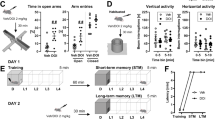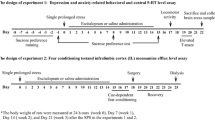Abstract
Conditioned fear stress (CFS)-induced freezing behavior has been proposed as an animal model of anxiety. In the present study, freezing was used to determine the anxiolytic activity of selective serotonin reuptake inhibitors (SSRIs), which are reported to be clinically effective in anxiety disorders. The duration of freezing behavior was reduced by acute treatment with the SSRIs citalopram (1–10 mg/kg) and fluvoxamine (3–30 mg/kg). Acute treatment with the serotonin (5-HT)/noradrenaline (NA) mixed reuptake inhibitor milnacipran (3–30 mg/kg) also attenuated CFS-induced freezing, while acute treatment with the NA reuptake inhibitors maprotiline and ORG4428, and the dopamine (DA) reuptake inhibitor GBR12909 failed to alter CFS-induced freezing. These results indicate that facilitation of 5-HT availability in the brain produced by 5-HT reuptake inhibition reduces CFS-induced freezing behavior. CFS may be a useful model for detecting the anxiolytic potential of 5-HT reuptake inhibitors.
Similar content being viewed by others
References
Andersen PH (1989) The dopamine uptake inhibitor GBR 12909: selectivity and molecular mechanism of action. Eur J Pharmacol 166:493–504
Blanchard RJ, Blanchard DC (1969) Crouching as an index of fear. J Comp Physiol Psychol 67:370–375
Bodnoff SR, Suranyi-Cadotte B, Quirion R, Meaney MJ (1989) A comparison of the effects of diazepam versus several typical and atypical anti-depressant drugs in an animal model of anxiety. Psychopharmacology 97:277–280
Bolles RC (1970) Species-specific defense reactions and avoidance learning. Psychol Rev 77:32–48
Bolles RC, Collier AC (1976) The effect of predictive cues on freezing in rats. Anim Learn Behav 4:6–8
Bouton ME, Bolles RC (1980) Conditioned fear assessed by freezing and by the suppression of three different baselines. Anim Learn Behav 8:429–434
Boyer WF (1992) Potential indications for the selective serotonin reuptake inhibitors. Int Clin Psychopharmacol 6 [Suppl 5]: 5–12
Broekkamp CL, Berendsen HHG, Jenck F, Van Delft AML (1989) Animal models for anxiety and response to serotonergic drugs. Psychopathology 22:2–12
Claustre Y, Rivy JP, Dennis T, Scatton B (1986) Pharmacological studies on stress-induced increase in frontal cortical dopamine metabolism in the rat. J Pharmacol Exp Ther 238:693–700
Conti LH, Maciver CR, Ferkany JW, Abreu ME (1990) Footshock-induced freezing behavior in rats as a model for assessing anxiolytics. Psychopharmacology 102:492–497
Deutch AY, Tam SY, Roth RH (1985) Footshock and conditioned stress increase 3,4-dihydroxyphenylacetic acid (DOPAC) in the ventral tegmental area but not substantia nigra. Brain Res 333:143–146
Eriksson E, Humble M (1990) Serotonin in psychiatric pathophysiology: a review of data from experimental and clinical research. In: Pohl R, Gershon S (eds) Progress in basic clinical pharmacology, vol.3. The biological basis of psychiatric treatment. Karger, Basel, pp 66–119
Fanselow MS (1980) Conditional and unconditional components of post-shock freezing. Pavlov J Biol Sci 15:177–182
Fanselow MS, Helmstetter FJ (1988) Conditional analgesia, defensive freezing, and benzodiazepines. Behav Neurosci 102:233–243
Gottfries CG (1989) Pharmacological treatment strategies in dementia disorder. Pharmacopsychiatry 22:129–134
Griebel G, Moreau JL, Jenck F, Misslin R, Martin JR (1994) Acute and chronic treatment with 5-HT reuptake inhibitors differentially modulate emotional responses in anxiety models in rodents. Psychopharmacology 113:463–470
Hard E, Engel J, Larsson K, Musi B (1985) Effect of diazepam, apomorphine and haloperidol on the audiogenic immobility reaction and on open field behavior. Psychopharmacology 85:106–110
Herman JP, Guillonneau D, Dantzer R, Scatton B, Semerdjian-Rouquier L, Le Moal M (1982) Differential effects of inescapable footshocks and of stimuli previously paired with inescapable footshocks on dopamine turnover in cortical and limbic areas of the rat. Life Sci 30:2207–2214
Inoue T, Koyama T, Yamashita I (1993) Effect of conditioned fear stress on serotonin metabolism in the rat brain. Pharmacol Biochem Behav 44:371–374
Inoue T, Tsuchiya K, Koyama T (1994) Regional changes in dopamine and serotonin activation with various intensity of physical and psychological stress in the rat brain. Pharmacol Biochem Behav 49:911–920
Kahn RJ, McNair DM, Lipman RS, Covi L, Rickels K, Downing R, Fisher S, Frankenthaler LM (1986) Imipramine and chlordiazepoxide in depressive and anxiety disorder, II: effcacy in anxious outpatients. Arch Gen Psychiatry 43:79–85
Kalin NH, Sherman JE, Takahashi LK (1988) Antagonism of endogenous CRH systems attenuates stress-induced freezing behavior in rats. Brain Res 457:130–135
Moret C, Charveron M, Finberg JPM, Couzinier JP, Briley M (1985) Biochemical profile of midalcipran (F 2207), 1-phenyl-1-diethyl-aminocarbonyl-2-aminomethyl-cyclopropane (Z) hydrochloride, a potential fourth generation antidepressant drug. Neuropharmacology 24:1211–1219
Njung'e K, Handley SL (1991) Effects of 5-HT uptake inhibitors, agonists and antagonists on the burying of harmless objects by mice: a putative test for anxiolytic agents. Br J Pharmacol 104:105–112
Nutt DJ, Glue P (1989) Clinical pharmacology of anxiolytics: a psychopharmacological perspective. Pharmacol Ther 44:309–334
Ohmori T, Abekawa T, Muraki A, Koyama T (1994) Competitive and noncompetitive NMDA antagonists block sensitization to methamphetamine. Pharmacol Biochem Behav 48:587–591
Organon Japan Co. (1993) ORG4428 Investigator Brochure. p 14
Rittenhouse PA, Bakkum EA, O'Connor PA, Carnes M, Bethea CL, Van de Kar LD (1992) Comparison of neuroendocrine and behavioral effects of ipsapirone, a 5-HT1A agonist, in three stress paradigms: immobilization, forced swim and conditioned fear. Brain Res 580:205–214
Richelson E, Pfenning M (1984) Blockade by antidepressants and related compounds of biogenic amine uptake into rat brain synaptosomes: most antidepressants selectively block norepinephrine uptake. Eur J Pharmacol 104:277–286
Rickels K, Downing R, Schweizer E, Hassman H (1993) Antidepressants for the treatment of generalized anxiety disorder: a placebo-controlled comparison of imipramine, trazodone, and diazepam. Arch Gen Psychiatry 50:884–895
Sherman JE, Kalin NH (1988) ICV-CRH alters stress-induced freezing behavior without affecting pain sensitivity. Pharmacol Biochem Behav 30:801–807
Tsuda A, Tanaka M, Ida Y Tsujimaru S, Ushijima I, Nagasaki N (1986) Effect of preshock experience on enhancement of rat brain noradrenaline turnover induced by psychological stress. Pharmacol Biochem Behav 24:115–119
Author information
Authors and Affiliations
Rights and permissions
About this article
Cite this article
Hashimoto, S., Inoue, T. & Koyama, T. Serotonin reuptake inhibitors reduce conditioned fear stress-induced freezing behavior in rats. Psychopharmacology 123, 182–186 (1996). https://doi.org/10.1007/BF02246175
Received:
Revised:
Issue Date:
DOI: https://doi.org/10.1007/BF02246175




